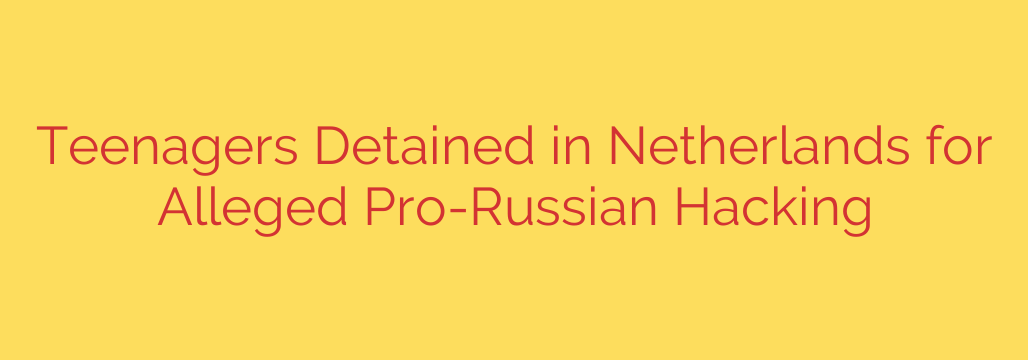
Teen Hackers Detained: The Alarming Rise of Youth in Geopolitical Cyberattacks
A concerning new front has opened in the world of geopolitical conflict, moving from battlefields to the digital realm, and its newest recruits are surprisingly young. Recent events in the Netherlands have brought this issue into sharp focus, as Dutch authorities detained multiple teenagers for their alleged involvement in a series of debilitating cyberattacks.
The arrests highlight a significant and troubling trend: the recruitment and participation of young individuals in sophisticated, politically motivated cyber warfare. These teenagers are suspected of acting on behalf of a pro-Russian hacktivist collective, targeting critical infrastructure and institutions within the Netherlands.
The Targets: A Direct Hit on National Infrastructure
The wave of cyberattacks was not random. The targets were strategically chosen to cause maximum disruption and attract widespread attention. Among the institutions hit were the Port of Rotterdam, one of Europe’s busiest and most vital shipping hubs, and several major Dutch banks.
These attacks were primarily executed as Distributed Denial-of-Service (DDoS) campaigns. A DDoS attack works by overwhelming a website or online service with a flood of malicious traffic from countless sources, making it inaccessible to legitimate users. For a major port or a financial institution, such an outage can result in significant economic damage and a loss of public trust.
The selection of these high-profile targets demonstrates a clear intent to disrupt the national economy and create a sense of instability, underscoring the serious real-world consequences of these digital assaults.
Understanding the Weapon: What is a DDoS Attack?
To understand the gravity of these events, it’s crucial to grasp the nature of the weapon used. A Distributed Denial-of-Service (DDoS) attack is a blunt-force instrument of cyber warfare. Imagine thousands of cars intentionally gridlocking every road leading to a major hospital, preventing anyone from getting in or out. That’s essentially what a DDoS attack does to a digital service.
Hacktivist groups favor DDoS attacks for several reasons:
- Accessibility: The tools to launch such attacks are often readily available on the dark web.
- Anonymity: Attackers can obscure their identities by using networks of compromised computers (botnets).
- High Impact: They are highly disruptive and effective at grabbing headlines, which is often the primary goal of hacktivist groups.
While not as technically sophisticated as data breaches, the disruptive power of a sustained DDoS campaign against critical infrastructure cannot be underestimated.
The Youth Factor: Why Are Teens Getting Involved?
The involvement of teenagers in state-aligned hacking raises urgent questions about motivation and radicalization. Several factors may contribute to this trend:
- Ideological Alignment: Some young people may be drawn to the political or nationalist ideology of these hacktivist groups, seeing their actions as a form of digital patriotism.
- A Sense of Power: The ability to disrupt major institutions from a keyboard can provide a powerful, albeit misguided, sense of influence and importance.
- Gamification of Hacking: Online communities and forums can present cyberattacks as a game, with leaderboards and recognition for successful “missions,” divorcing the act from its severe real-world impact.
- Underestimation of Consequences: Many young participants may not fully grasp the severe legal ramifications of their actions, which can include hefty fines and significant prison sentences.
This case serves as a stark reminder that cybercriminals are not a monolith. They can be teenagers operating from their bedrooms, easily swayed by online rhetoric and unaware of the gravity of their crimes.
Actionable Security and Guidance for a New Digital Era
The Dutch arrests are a wake-up call for governments, businesses, and parents alike. Protecting against these threats requires a multi-layered approach.
For Businesses and Organizations:
- Implement Robust DDoS Protection: Proactive DDoS mitigation services are no longer a luxury but a necessity for any organization with a critical online presence. These services can detect and filter malicious traffic before it reaches your network.
- Develop an Incident Response Plan: Know exactly what to do when an attack occurs. This plan should outline communication strategies, technical responses, and key personnel roles to minimize downtime and damage.
- Strengthen Network Security: Ensure all systems are patched, firewalls are properly configured, and network monitoring is in place to detect unusual activity.
For Parents and Educators:
- Foster Open Communication: Talk to young people about their online activities and the communities they are part of. Understanding their digital world is the first step to guiding them.
- Educate on Legal and Ethical Consequences: Ensure they understand that hacking is a serious crime with life-altering consequences, not a harmless prank or game.
- Promote Ethical Tech Skills: Channel an interest in technology and coding into positive, legal avenues. Encourage participation in “white-hat” hacking competitions, cybersecurity clubs, and educational programs that build constructive skills for a future career.
The digital landscape is evolving, and with it, the nature of global conflict. These recent arrests underscore the urgent need for enhanced cybersecurity defenses and, just as importantly, for proactive education to steer young talent away from the destructive path of cybercrime.
Source: https://securityaffairs.com/182724/intelligence/dutch-teens-arrested-for-spying-on-behalf-of-pro-russian-hackers.html








